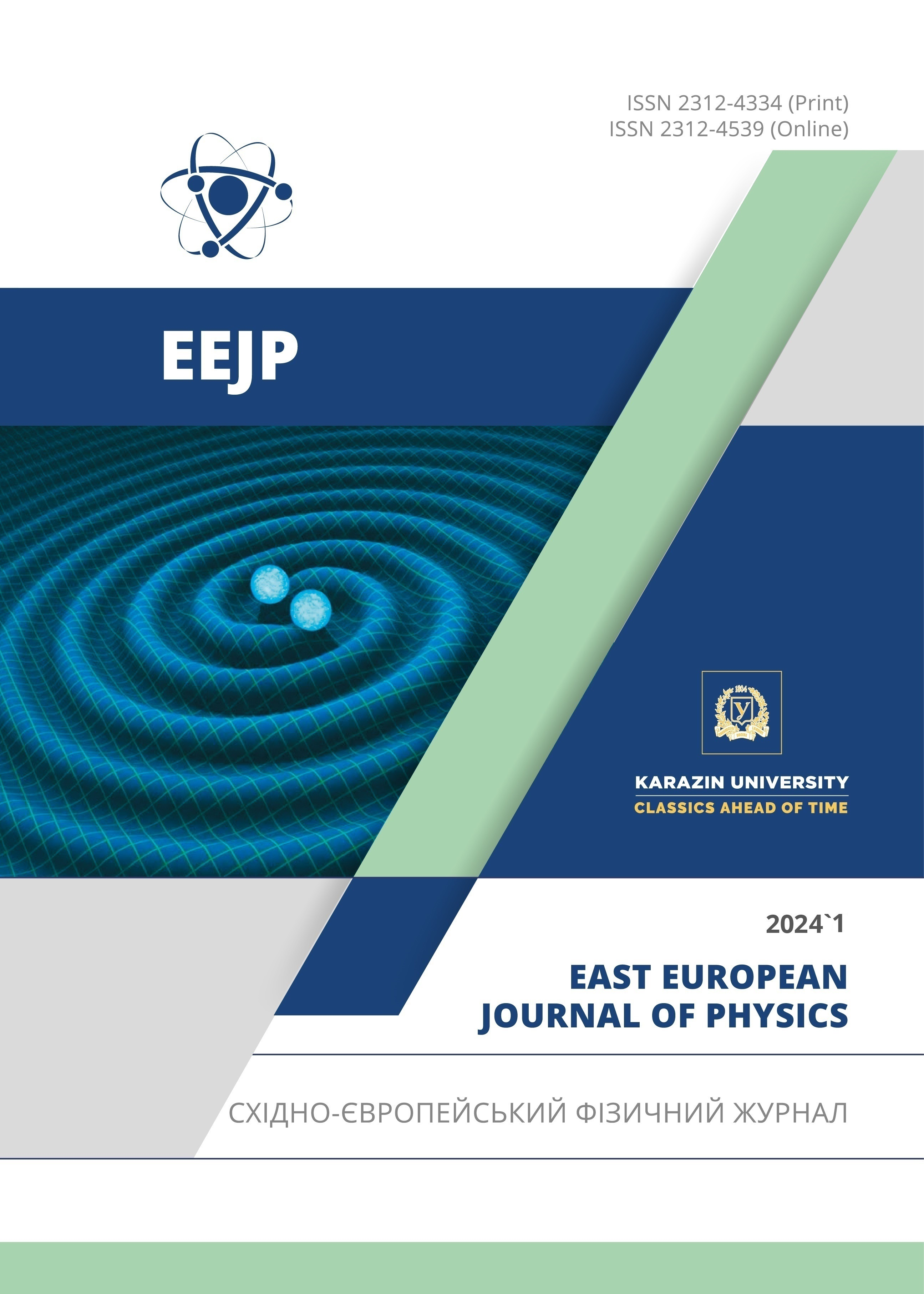Vibrational Hamiltonian of Carbonyl Sulphide and Hydrogen Cyanide
Abstract
This study thoroughly investigates the vibrational frequencies of carbonyl sulphide (12C16O32S) and hydrogen cyanide (HCN) up to the fifth harmonic level. It offers comprehensive insights into vibrational modes by using the Hamiltonian operator formalism and concentrating on invariant operators and algebraic parameters with a one-dimensional Lie algebraic method. The findings are significant for atmospheric chemistry, spectroscopy, and quantum chemistry, contributing to a deeper understanding of molecular dynamics. This research sets the groundwork for future studies in comparable compounds and applications.
Downloads
References
F. Iachello, “Algebraic methods for molecular rotation-vibration spectra,” Chem. Phys. Lett. 78(3), 581-585 (1981). https://doi.org/10.1016/0009-2614(81)85262-1
F. Iachello, and R.D. Levine, Algebraic theory of molecules, (Oxford University Press, Oxford, 1995).
S. Oss, “Algebraic models in molecular spectroscopy,” in: Advances in Chemical Physics: New Methods in Computational Quantum Mechanics, edited by I. Prigogine, and S.A. Rice, vol. 93, (John Wiley & Sons, Inc., 1996). pp. 455 649. https://doi.org/10.1002/9780470141526.ch8
F. Iachello, and A. Arima, The interacting Boson model, (Cambridge University Press, Cambridge, 1987).
M.R. Balla, and V. Jaliparthi, “Vibrational Hamiltonian of Methylene Chloride Using U(2) Lie Algebra,” Mol. Phys. 115, e1828634 (2021). https://doi.org/10.1080/00268976.2020.1828634
M.R. Balla, S. Venigalla, V. Jaliparthi, “Calculation of Vibrational Frequencies of Sulfur Dioxide by Lie Algebraic Framework,” Acta Phys. Pol. A, 140(2), 138-140 (2021). https://doi.org/10.12693/APhysPolA.140.138
V. Jaliparthi, “Vibrational Energies of Silylene, Difluorosilylene and Dichlorosilylene, Using U(2) Lie Algebraic Model,” Ukr. J. Phys. Opt. 23(3), 126-132 (2022). https://doi.org/10.3116/16091833/23/3/126/2022
N.K. Sarkar, J. Choudhury, S.R. Karumuri, and R. Bhattacharjee, “A comparative study of the vibrational spectra of OCS and HCP using the Lie algebraic method,” Eur. Phys. J. D, 53, 163–171 (2009). https://doi.org/10.1140/epjd/e2009-00094-8
N.K. Sarkar, J. Choudhury, and R. Bhattacharjee, “An algebraic approach to the study of the vibrational spectra of HCN,” Molecular Physics, 104(19), 3051-3055 (2006). https://doi.org/10.1080/00268970600954235
A. Mengoni, and T. Shirai, “Vibron Model Description of Vibrational Spectra of the HCO and DCO Molecules,” J. Mol. Spectrosc. 162(1), 246-256 (1993). https://doi.org/10.1006/jmsp.1993.1281
M.R. Balla, and V. Jaliparthi, “Vibrational Hamiltonian of Naphthalene (C10H8) Using Dynamical U(2) Lie Algebras,” Polycycl. Aromat. Compd. 42(7), 4684-4699 (2022). https://doi.org/10.1080/10406638.2021.1901126
V. Jaliparthi, and M.R. Balla, “Vibrational Hamiltonian of Tetrachloro-, Tetrafluoro-, and Mono- Silanes Using U(2) Lie Algebras,” Spectrochim. Acta A, 264, 120289 (2022). https://doi.org/10.1016/j.saa.2021.120289
K. Nakamoto, Infrared and Raman Spectra of Inorganic and Coordination Compounds: Part A: Theory and Applications in Inorganic Chemistry, (Wiley, New York, 2009).
K.P. Huber, and G. Herzberg, Molecular Spectra and Molecular Structure. IV: Constants of Diatomic Molecules, (Van Nostrand Reinhold, New York, 1979.
K.K. Irikura, “Experimental Vibrational Zero-Point Energies: Diatomic Molecules,” J. Phys. Chem. Ref. Data, 36(2), 389-397 (2007). https://doi.org/10.1063/1.3167794
T. Shimanouchi, Tables of Molecular Vibrational Frequencies Consolidated, vol. I, National Bureau of Standards, 39, 1 160 (U.S. Government Printing Office, 1972). https://nvlpubs.nist.gov/nistpubs/Legacy/NSRDS/nbsnsrds39.pdf
Copyright (c) 2024 K. Lavanya, A. Ganapathi Rao, J. Vijayasekhar

This work is licensed under a Creative Commons Attribution 4.0 International License.
Authors who publish with this journal agree to the following terms:
- Authors retain copyright and grant the journal right of first publication with the work simultaneously licensed under a Creative Commons Attribution License that allows others to share the work with an acknowledgment of the work's authorship and initial publication in this journal.
- Authors are able to enter into separate, additional contractual arrangements for the non-exclusive distribution of the journal's published version of the work (e.g., post it to an institutional repository or publish it in a book), with an acknowledgment of its initial publication in this journal.
- Authors are permitted and encouraged to post their work online (e.g., in institutional repositories or on their website) prior to and during the submission process, as it can lead to productive exchanges, as well as earlier and greater citation of published work (See The Effect of Open Access).








